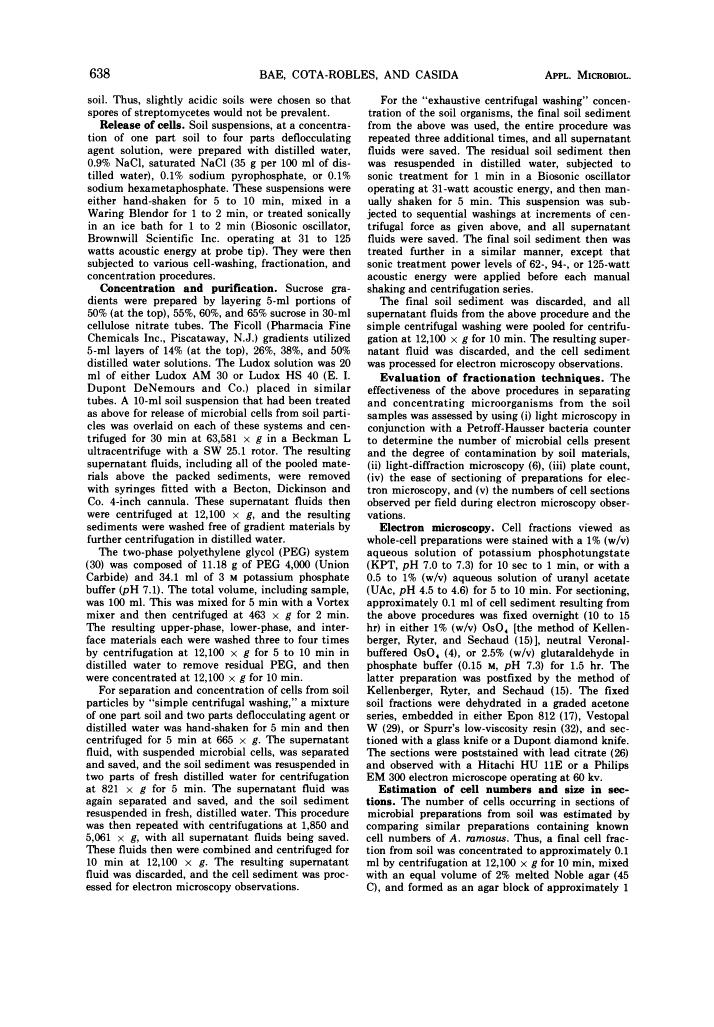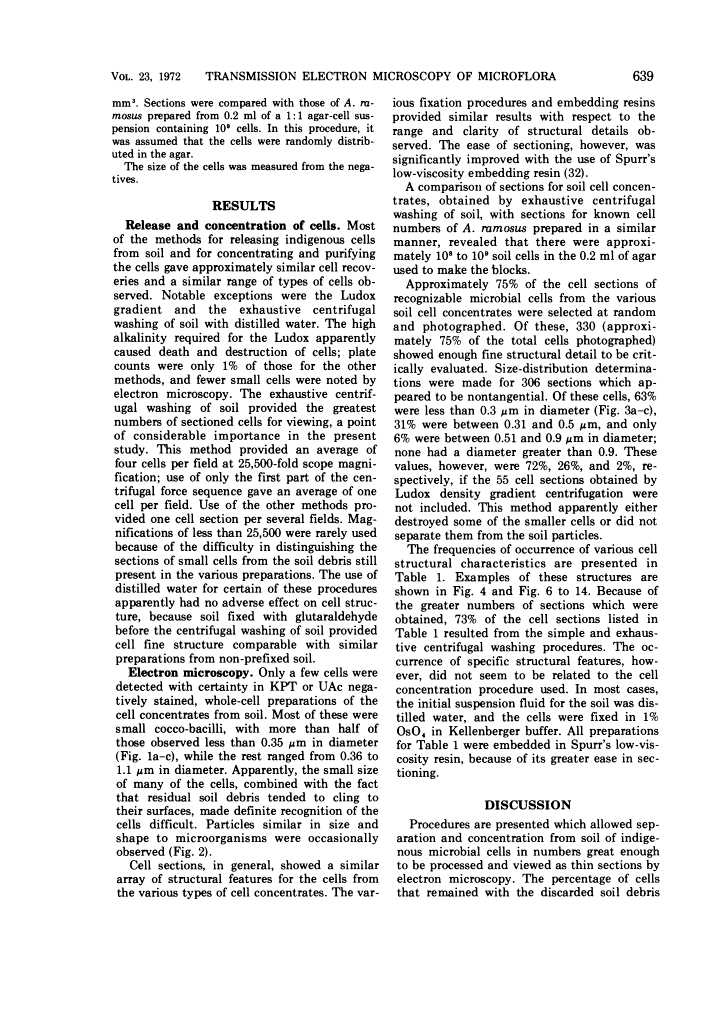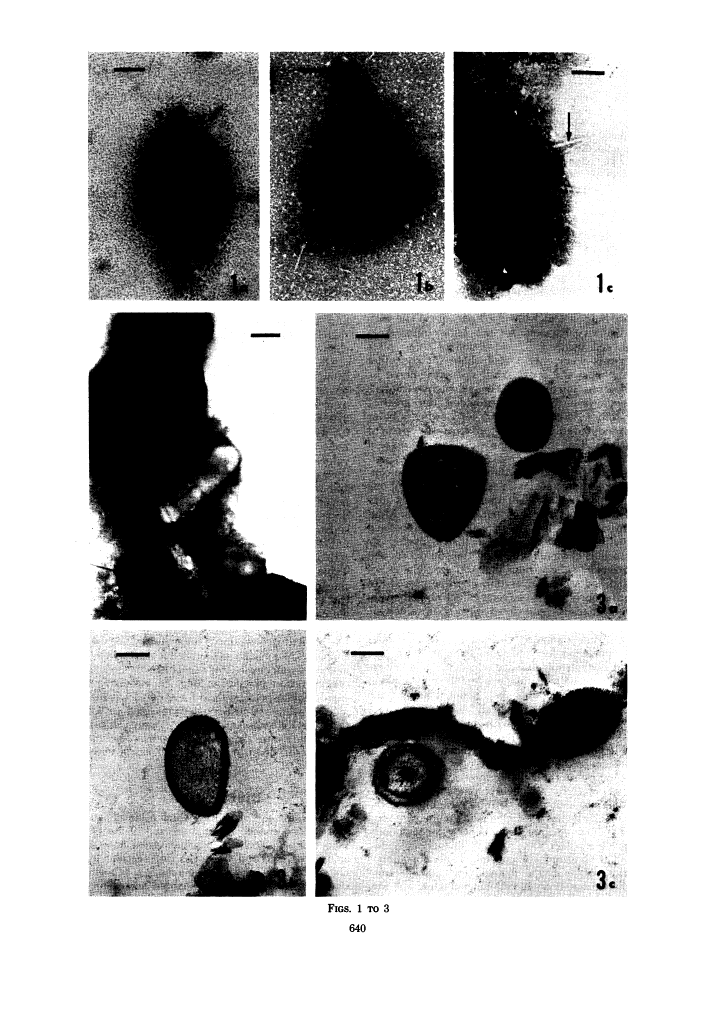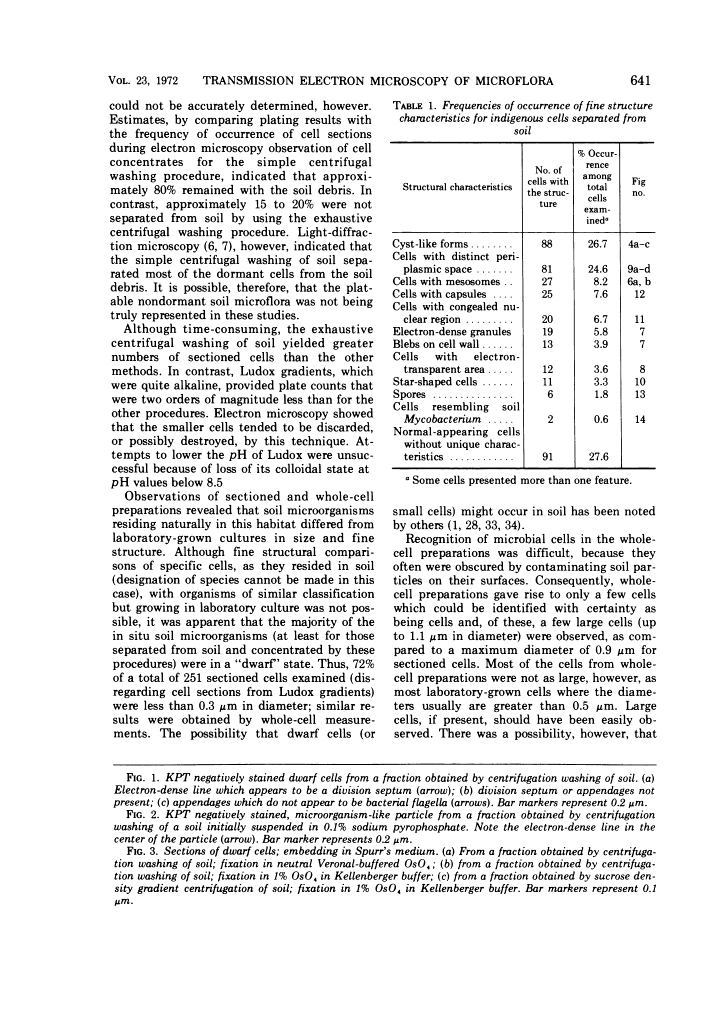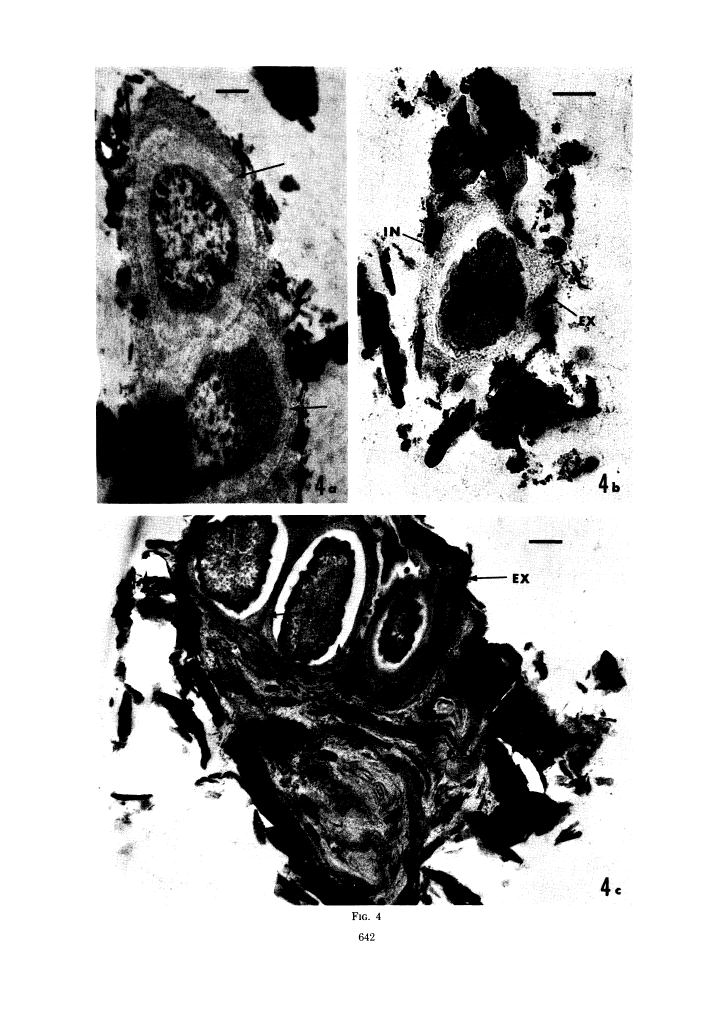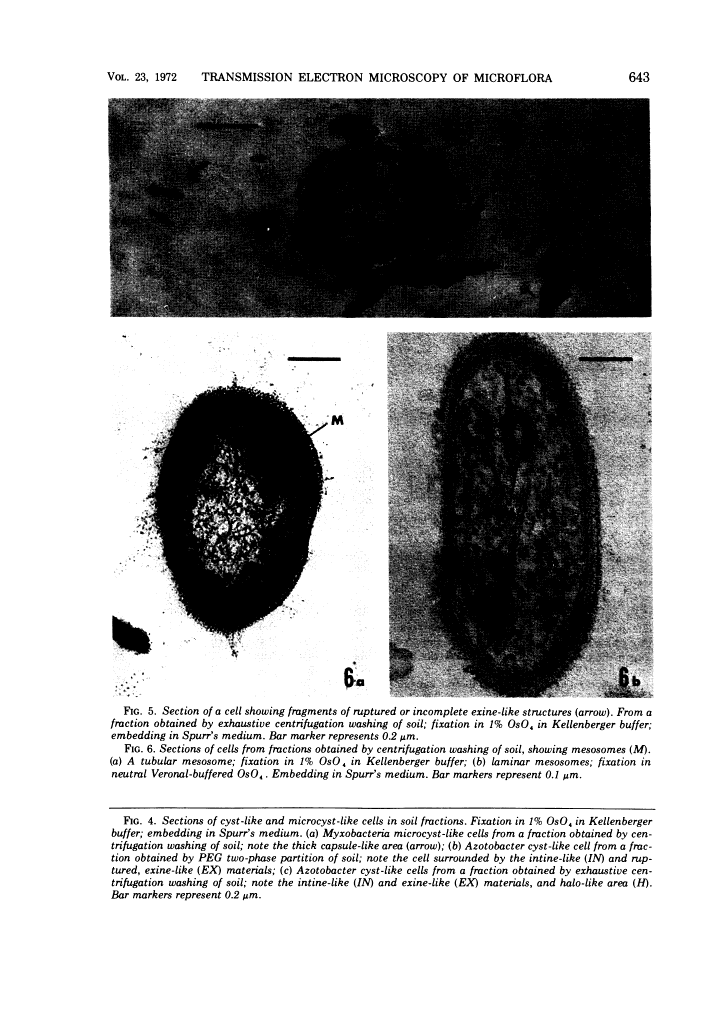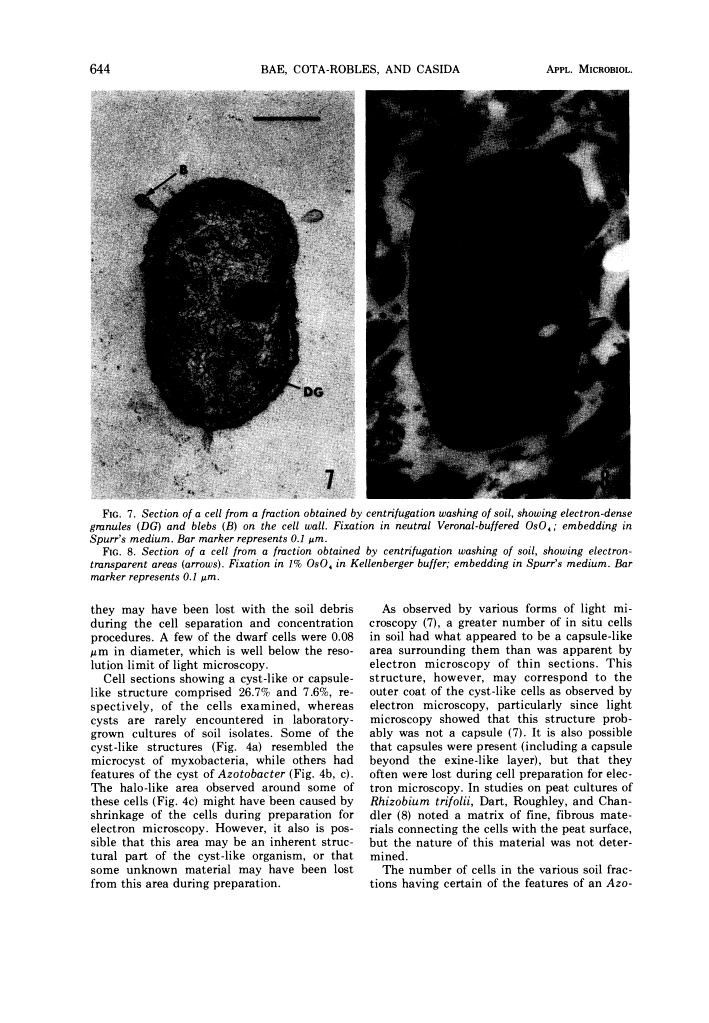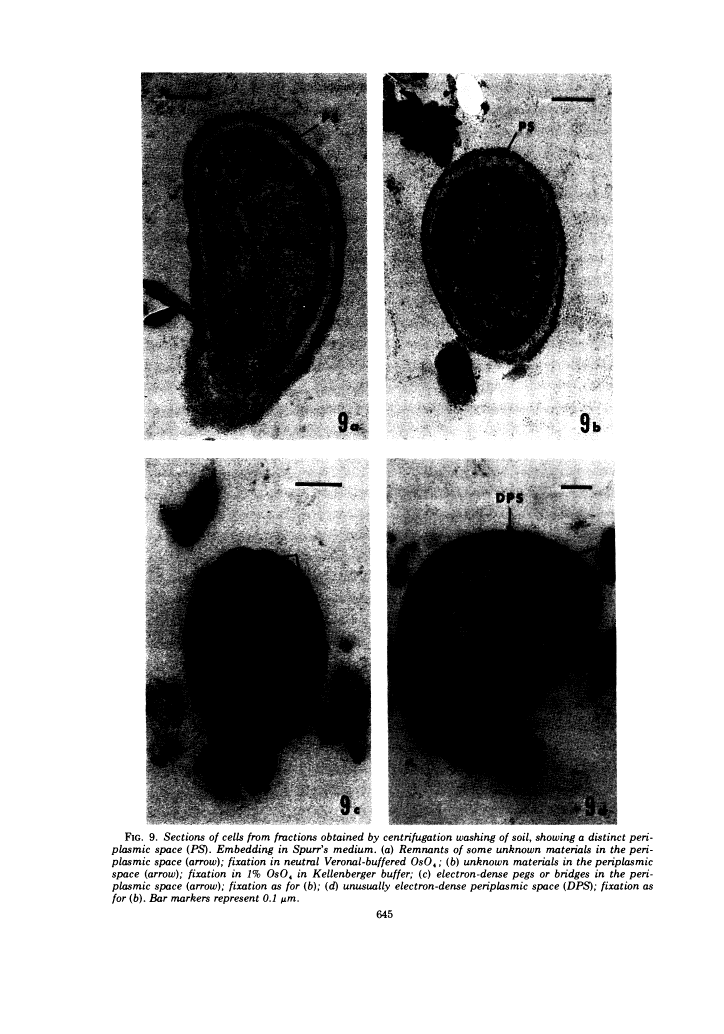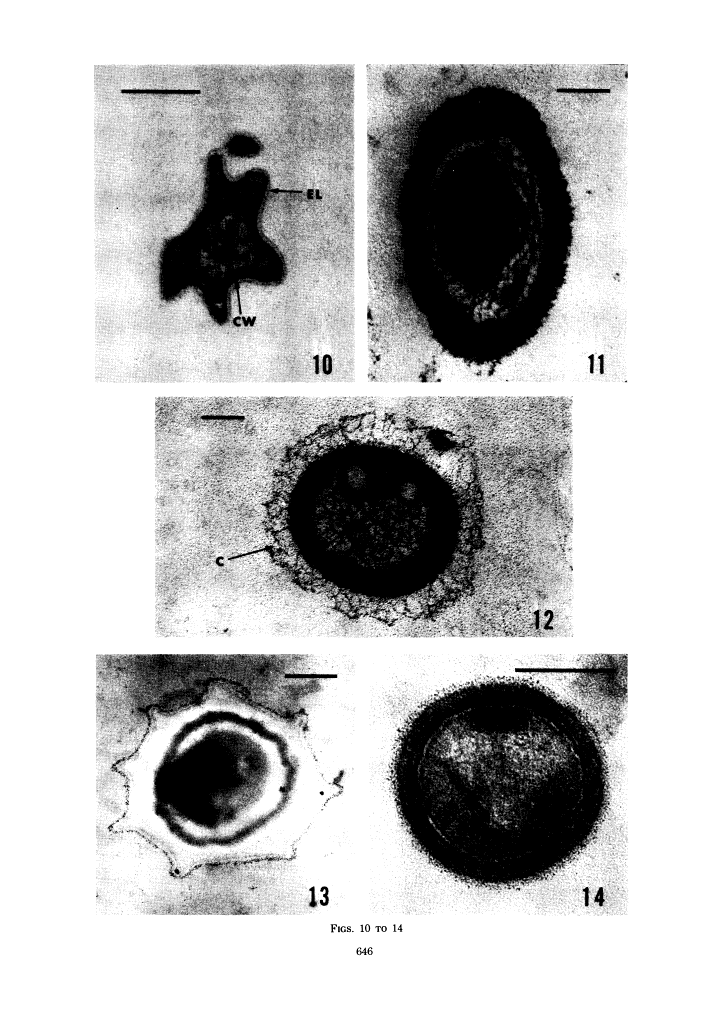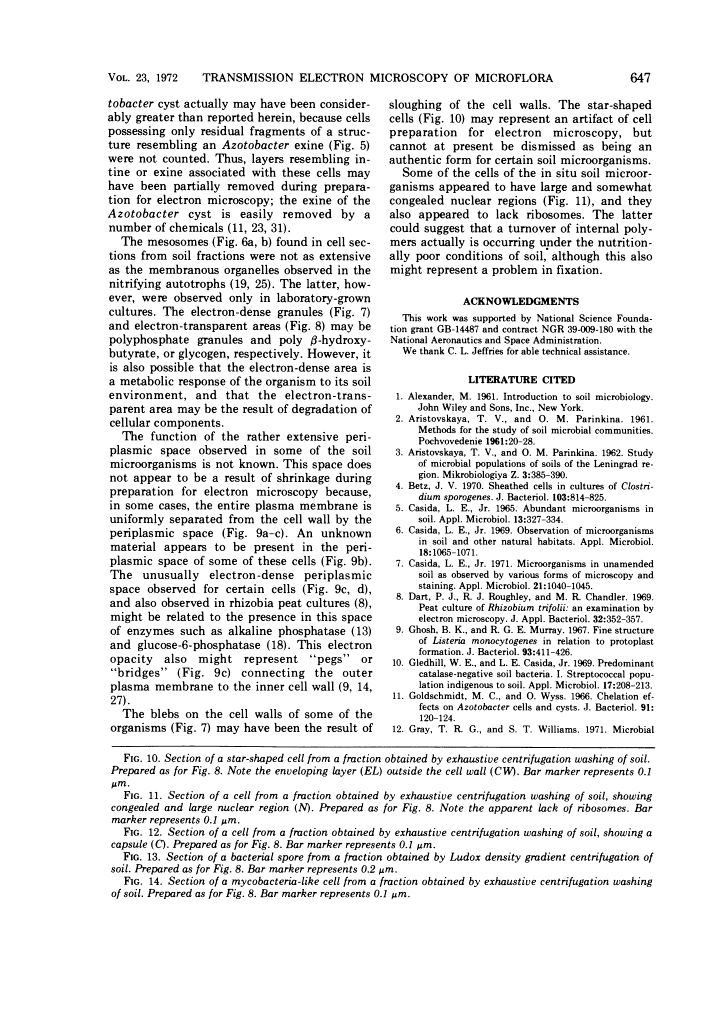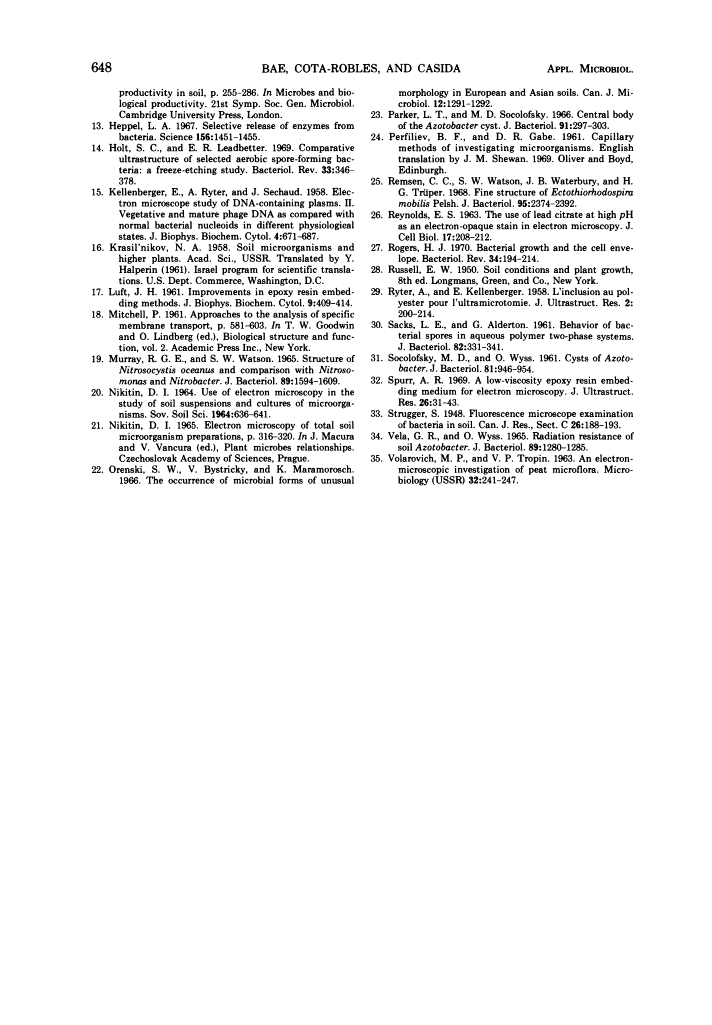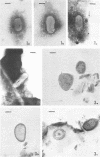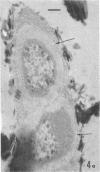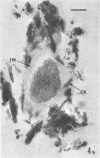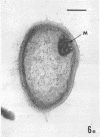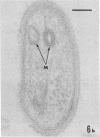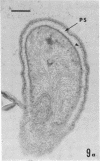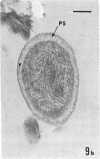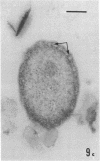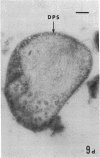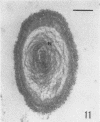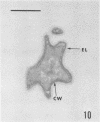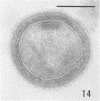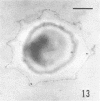Abstract
Free full text

Microflora of Soil as Viewed by Transmission Electron Microscopy1
Abstract
Several procedures were evaluated for separating and concentrating indigenous microorganisms from soil without the occurrence of growth. Electron microscopy of nontangential, thin sections through these cells revealed that all of the cells examined were less than 0.9 μm in diameter, and up to 72% were „dwarf” cells less than 0.3 μm in diameter. Some were small enough that they should not be resolved with the light microscope. Approximately 27% had a fine structure bearing some resemblance to that of a bacterial cyst or microcyst, but this value may be low because cells having their outer layers partially stripped off were not included in the count. Approximately 25% showed a distinct periplasmic space, which often contained stainable material. Other fine structure features are presented together with frequencies of occurrence for the populations examined.
Full text
Full text is available as a scanned copy of the original print version. Get a printable copy (PDF file) of the complete article (6.1M), or click on a page image below to browse page by page. Links to PubMed are also available for Selected References.
Images in this article
Selected References
These references are in PubMed. This may not be the complete list of references from this article.
- Betz JV. Sheathed cells in cultures of Clostridium sporogenes. J Bacteriol. 1970 Sep;103(3):814–825. [Europe PMC free article] [Abstract] [Google Scholar]
- CASIDA LE., Jr ABUNDANT MICROORGANISM IN SOIL. Appl Microbiol. 1965 May;13:327–334. [Europe PMC free article] [Abstract] [Google Scholar]
- Casida LE., Jr Observation of microorganisms in soil and other natural habitats. Appl Microbiol. 1969 Dec;18(6):1065–1071. [Europe PMC free article] [Abstract] [Google Scholar]
- Casida LE., Jr Microorganisms in unamended soil as observed by various forms of microscopy and staining. Appl Microbiol. 1971 Jun;21(6):1040–1045. [Europe PMC free article] [Abstract] [Google Scholar]
- Ghosh BK, Murray RG. Fine structure of Listeria monocytogenes in relation to protoplast formation. J Bacteriol. 1967 Jan;93(1):411–426. [Europe PMC free article] [Abstract] [Google Scholar]
- Gledhill WE, Casida LE., Jr Predominant catalase-negative soil bacteria. I. Streptococcal population indigenous to soil. Appl Microbiol. 1969 Feb;17(2):208–213. [Europe PMC free article] [Abstract] [Google Scholar]
- Goldschmidt MC, Wyss O. Chelation effects on Azotobacter cells and cysts. J Bacteriol. 1966 Jan;91(1):120–124. [Europe PMC free article] [Abstract] [Google Scholar]
- Heppel LA. Selective release of enzymes from bacteria. Science. 1967 Jun 16;156(3781):1451–1455. [Abstract] [Google Scholar]
- Holt SC, Leadbetter ER. Comparative ultrastructure of selected aerobic spore-forming bacteria: a freeze-etching study. Bacteriol Rev. 1969 Jun;33(2):346–378. [Europe PMC free article] [Abstract] [Google Scholar]
- KELLENBERGER E, RYTER A, SECHAUD J. Electron microscope study of DNA-containing plasms. II. Vegetative and mature phage DNA as compared with normal bacterial nucleoids in different physiological states. J Biophys Biochem Cytol. 1958 Nov 25;4(6):671–678. [Europe PMC free article] [Abstract] [Google Scholar]
- LUFT JH. Improvements in epoxy resin embedding methods. J Biophys Biochem Cytol. 1961 Feb;9:409–414. [Europe PMC free article] [Abstract] [Google Scholar]
- MURRAY RG, WATSON SW. STRUCTURE OF NITROSOCYSTIS OCEANUS AND COMPARISON WITH NITROSOMONAS AND NITROBACTER. J Bacteriol. 1965 Jun;89:1594–1609. [Europe PMC free article] [Abstract] [Google Scholar]
- Orenski SW, Bystricky V, Maramorosch K. The occurrence of microbial forms of unusual morphology in European and Asian soils. Can J Microbiol. 1966 Dec;12(6):1291–1292. [Abstract] [Google Scholar]
- Parker LT, Socolofsky MD. Central body of the Azotobacter cyst. J Bacteriol. 1966 Jan;91(1):297–303. [Europe PMC free article] [Abstract] [Google Scholar]
- Remsen CC, Watson SW, Waterbury JB, Trüper HG. Fine structure of Ectothiorhodospira mobilis Pelsh. J Bacteriol. 1968 Jun;95(6):2374–2392. [Europe PMC free article] [Abstract] [Google Scholar]
- REYNOLDS ES. The use of lead citrate at high pH as an electron-opaque stain in electron microscopy. J Cell Biol. 1963 Apr;17:208–212. [Europe PMC free article] [Abstract] [Google Scholar]
- Rogers HJ. Bacterial growth and the cell envelope. Bacteriol Rev. 1970 Jun;34(2):194–214. [Europe PMC free article] [Abstract] [Google Scholar]
- RYTER A, KELLENBERGER E. L'inclusion au polyester pour l'ultramicrotomie. J Ultrastruct Res. 1958 Dec;2(2):200–214. [Abstract] [Google Scholar]
- SACKS LE, ALDERTON G. Behavior of bacterial spores in aqueous polymer two-phase systems. J Bacteriol. 1961 Sep;82:331–341. [Europe PMC free article] [Abstract] [Google Scholar]
- Socolofsky MD, Wyss O. CYSTS OF AZOTOBACTER. J Bacteriol. 1961 Jun;81(6):946–954. [Europe PMC free article] [Abstract] [Google Scholar]
- Spurr AR. A low-viscosity epoxy resin embedding medium for electron microscopy. J Ultrastruct Res. 1969 Jan;26(1):31–43. [Abstract] [Google Scholar]
- VELVA GR, WYSS O. RADIATION RESISTANCE OF SOIL AZOTOBACTER. J Bacteriol. 1965 May;89:1280–1285. [Europe PMC free article] [Abstract] [Google Scholar]
Associated Data
Articles from Applied Microbiology are provided here courtesy of American Society for Microbiology (ASM)
Full text links
Read article at publisher's site: https://doi.org/10.1128/am.23.3.637-648.1972
Read article for free, from open access legal sources, via Unpaywall:
https://aem.asm.org/content/aem/23/3/637.full.pdf
Citations & impact
Impact metrics
Citations of article over time
Article citations
Bioactive metabolites of Streptomyces misakiensis display broad-spectrum antimicrobial activity against multidrug-resistant bacteria and fungi.
Front Cell Infect Microbiol, 13:1162721, 24 Apr 2023
Cited by: 2 articles | PMID: 37168394 | PMCID: PMC10165089
A New Method and Mass-Spectrometric Instrument for Extraterrestrial Microbial Life Detection Using the Elemental Composition Analyses of Martian Regolith and Permafrost/Ice.
Astrobiology, 17(5):448-458, 01 May 2017
Cited by: 1 article | PMID: 28520473
Characterisation of a stable laboratory co-culture of acidophilic nanoorganisms.
Sci Rep, 7(1):3289, 12 Jun 2017
Cited by: 34 articles | PMID: 28607432 | PMCID: PMC5468238
Biological reference materials for extracellular vesicle studies.
Eur J Pharm Sci, 98:4-16, 10 Sep 2016
Cited by: 35 articles | PMID: 27622921
The rebirth of culture in microbiology through the example of culturomics to study human gut microbiota.
Clin Microbiol Rev, 28(1):237-264, 01 Jan 2015
Cited by: 436 articles | PMID: 25567229 | PMCID: PMC4284300
Review Free full text in Europe PMC
Go to all (53) article citations
Similar Articles
To arrive at the top five similar articles we use a word-weighted algorithm to compare words from the Title and Abstract of each citation.
Responses of indigenous microorganisms to soil incubation as viewed by transmission electron microscopy of cell thin sections.
J Bacteriol, 113(3):1462-1473, 01 Mar 1973
Cited by: 14 articles | PMID: 4691389 | PMCID: PMC251718
Microflora of soil as viewed by freeze-etching.
J Bacteriol, 114(3):1319-1327, 01 Jun 1973
Cited by: 10 articles | PMID: 4123238 | PMCID: PMC285395
[Light and electron microscope studies on cysts of Sarcocystis fusiformis in the muscles of calves infected experimentally with oocysts and sporocysts of the large form of Isospora bigemina from dogs. 1. The development of cysts and "cyst wall" (author's transl)].
Zentralbl Bakteriol Orig A, 232(2-3):392-409, 01 Jul 1975
Cited by: 2 articles | PMID: 809948
Electron microscopy and atomic force microscopy studies of chromatin and metaphase chromosome structure.
Micron, 42(8):733-750, 12 May 2011
Cited by: 30 articles | PMID: 21703860
Review

